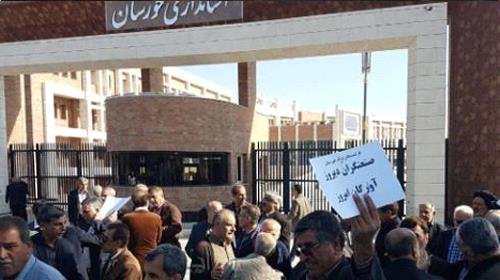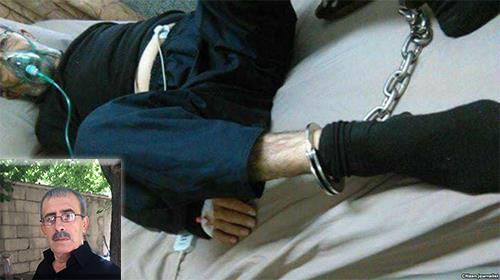Protests continue in Iran as workers stand up to the regime
The workers are protesting in front of Khuzistan province
These protests cross the lines from agricultural workers to mine employees and retirees

Feb. 7, 2018 - The #Iranian regime would have the international community believe that the #Protests, which started in late December of 2017, have ended. The truth is that various protests are ongoing, particularly as Iranian workers continue to protest on a variety of issues.
The news from the network of People’s Mojahedin Organization of #iran (PMOI/MEK) inside Iran paints a picture of continuing protests of injustices and non-payment of salaries. These protests cross the lines from agricultural workers to mine employees and retirees.
On February 5, agricultural workers started their sixth day of protest at a local factory in the Khuzestan province.
They were trying to bring to light the injustices they have endured from the management. Retired workers from this factory have not received their pension payments for over a year. The protest included workers from a variety of sectors, including agriculture, manufacturing, engineering, and commerce. These workers collectively went to the company’s yard, closed the gate, and prevented the movement of the trucks out of the factory.
In Isfahan and Ahvaz, retired personnel of the Steel and Mine Industries of Isfahan and Ahwaz held a protest rally. These retirees gathered in front of the retirement board while Ahwaz retirees gather in front of the governorate. The issue again appears to be focused on a lack of payment of pensions.
Lack of payment on workers an pensions
The lack of payment of pensions is part of the larger economic issues that plague the #Iranian People.
The corruption throughout the banking industry and the regime have left the Iranian people, both old and young, with limited options in terms of jobs and economic security.
It impacts the ability of the economy to grow and recover, something that the Iranian people were sold as the reason for the 2015 #nuclear agreement, which included the lifting of various #sanctions. While the regime and its religious organizations, as well as the Islamic Revolutionary Guard Corps (IRGC), have benefited financially, the average Iranian is losing their limited aid from the government. For Iranians, the ability to find work and care for their families is being limited.
Many young Iranians are living with the reality of high unemployment and higher education degrees that are essentially worthless. Their anger is boiling and creating unrest, a reality that the regime has tried hard to contain, but which is making its way to the outside world. The international community is also taking notice of the regime’s efforts to suppress the voices of the Iranian people.
Promises are being made by the big business of the Iranian regime and the mullahs. Yet, those promises are empty, as months go by with no discernable change. In the case of workers from Hepco, the protests originally started months ago, when they were promised action regarding the non-payment of their salaries and the privatization of the company. Labor Minister Ali Rabiee and the governor of #Arak promised action but failed to do anything, hence the protesters were out again on February 5.
The month of February began with #protests [VIDEO], as the Iranian people continue to make their voices heard, despite threats of torture, imprisonment, and violence against their families. The conditions in Iran are reaching a boiling point. The question is what will bring the Iranian people to initiate regime change? It is also clear that the regime is fighting for its life and the Iranian people may be close to finally cutting that cord.
The news from the network of People’s Mojahedin Organization of #iran (PMOI/MEK) inside Iran paints a picture of continuing protests of injustices and non-payment of salaries. These protests cross the lines from agricultural workers to mine employees and retirees.
On February 5, agricultural workers started their sixth day of protest at a local factory in the Khuzestan province.
They were trying to bring to light the injustices they have endured from the management. Retired workers from this factory have not received their pension payments for over a year. The protest included workers from a variety of sectors, including agriculture, manufacturing, engineering, and commerce. These workers collectively went to the company’s yard, closed the gate, and prevented the movement of the trucks out of the factory.
In Isfahan and Ahvaz, retired personnel of the Steel and Mine Industries of Isfahan and Ahwaz held a protest rally. These retirees gathered in front of the retirement board while Ahwaz retirees gather in front of the governorate. The issue again appears to be focused on a lack of payment of pensions.
Lack of payment on workers an pensions
The lack of payment of pensions is part of the larger economic issues that plague the #Iranian People.
The corruption throughout the banking industry and the regime have left the Iranian people, both old and young, with limited options in terms of jobs and economic security.
It impacts the ability of the economy to grow and recover, something that the Iranian people were sold as the reason for the 2015 #nuclear agreement, which included the lifting of various #sanctions. While the regime and its religious organizations, as well as the Islamic Revolutionary Guard Corps (IRGC), have benefited financially, the average Iranian is losing their limited aid from the government. For Iranians, the ability to find work and care for their families is being limited.
Many young Iranians are living with the reality of high unemployment and higher education degrees that are essentially worthless. Their anger is boiling and creating unrest, a reality that the regime has tried hard to contain, but which is making its way to the outside world. The international community is also taking notice of the regime’s efforts to suppress the voices of the Iranian people.
Promises are being made by the big business of the Iranian regime and the mullahs. Yet, those promises are empty, as months go by with no discernable change. In the case of workers from Hepco, the protests originally started months ago, when they were promised action regarding the non-payment of their salaries and the privatization of the company. Labor Minister Ali Rabiee and the governor of #Arak promised action but failed to do anything, hence the protesters were out again on February 5.
The month of February began with #protests [VIDEO], as the Iranian people continue to make their voices heard, despite threats of torture, imprisonment, and violence against their families. The conditions in Iran are reaching a boiling point. The question is what will bring the Iranian people to initiate regime change? It is also clear that the regime is fighting for its life and the Iranian people may be close to finally cutting that cord.




Comments
Post a Comment